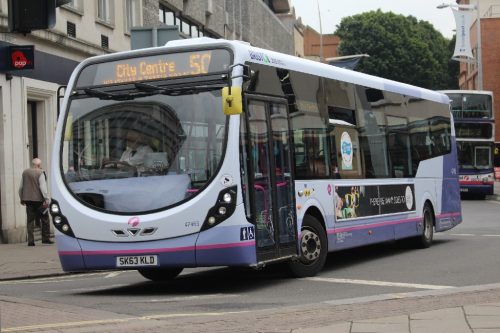
Affluent southern areas in particular performing well, with patronage up by 19% in Bristol over the last six years
A new report by the Low Carbon Vehicle Partnership (LowCVP), commissioned by Greener Journeys, has highlighted how bus services in many affluent southern regions are experiencing the biggest growth in bus patronage.
The areas include Bristol (19% increase from 2009/10 to 2015/16), Reading (17%), Milton Keynes (15%) and Oxfordshire (12%), all of which have benefited from investment and prioritisation by local councils in partnership with operators.
The boost is not entirely limited to the south, with York more recently experiencing a 7% increase in bus usage since 2011/12 – the equivalent of an extra 600,000 passenger journeys per year.
Popular improvements identified by the report, entitled ‘Any Journey is Greener by Bus,’ include cleaner vehicle technology, real-time travel information, integrated ticketing, free WiFi and charging, improved seating, shorter journey times, better routing and bus priority measures such as bus lanes.
The report stated that in some cities and regions, operators have introduced cleaner vehicle technology along with a host of other innovative features which are attracting people back to buses.
It adds: “Over the last 10 years, bus use has grown in the South West and South East of England, suggesting that the balance between private and shared travel for those living in the wealthiest, most congested, parts of the country may be gradually shifting in favour of the bus.”
A separate survey of more than 800 passengers across the UK found that convenience is the most common reason to choose the bus for their journey, with 57% of respondents naming it as a key factor. However, in the south east and south west – the regions where bus usage increased overall – passengers were more likely to cite avoiding traffic (30%) and environmental benefits (28%) as a main reason for travelling by bus.
Andy Eastlake, Managing Director of LowCVP, said: “This report, the third in a series on progress in the bus industry, shows that innovation in technology is a part – but only a part – of what will make passengers return to the buses in greater numbers.
“Buses have the potential to play a central role, particularly in cities of the future where the idea of mobility as a service is already becoming a reality. But, as these case studies show, the industry has to move fast to keep up with the game and deliver the kinds of services that modern passengers are coming to expect.”
Claire Haigh, CEO of Greener Journeys, said: “This new report clearly shows that investment in buses, and prioritisation of bus networks, can reap real rewards by increasing passenger numbers and taking more cars off the road, with all the economic, social and environmental benefits that brings.
“We would encourage councils and operators across the UK to look at the innovative services, measures for tackling congestion and clean bus technology detailed in this report as a model for raising usage and sparking their own bus renaissance.”

